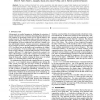Free Online Productivity Tools
i2Speak
i2Symbol
i2OCR
iTex2Img
iWeb2Print
iWeb2Shot
i2Type
iPdf2Split
iPdf2Merge
i2Bopomofo
i2Arabic
i2Style
i2Image
i2PDF
iLatex2Rtf
Sci2ools
VIS
2007
IEEE
2007
IEEE
Segmentation of Three-dimensional Retinal Image Data
We have combined methods from volume visualization and data analysis to support better diagnosis and treatment of human retinal diseases. Many diseases can be identified by abnormalities in the thicknesses of various retinal layers captured using optical coherence tomography (OCT). We used a support vector machine (SVM) to perform semi-automatic segmentation of retinal layers for subsequent analysis including a comparison of layer thicknesses to known healthy parameters. We have extended and generalized an older SVM approach to support better performance in a clinical setting through performance enhancements and graceful handling of inherent noise in OCT data by considering statistical characteristics at multiple levels of resolution. The addition of the multi-resolution hierarchy extends the SVM to have "global awareness." A feature, such as a retinal layer, can therefore be modeled within the SVM as a combination of statistical characteristics across all levels; thus captur...
Human Retinal Diseases | IEEE Visualization | Multiple Retinal Layers | Various Retinal Layers | VIS 2007 | Visualization |
| Added | 03 Nov 2009 |
| Updated | 03 Nov 2009 |
| Type | Conference |
| Year | 2007 |
| Where | VIS |
| Authors | Alfred R. Fuller, Rober t J. Zawadzki, Stacey Choi, David F. Wiley, John S. Werner, Bernd Hamann |
Comments (0)

